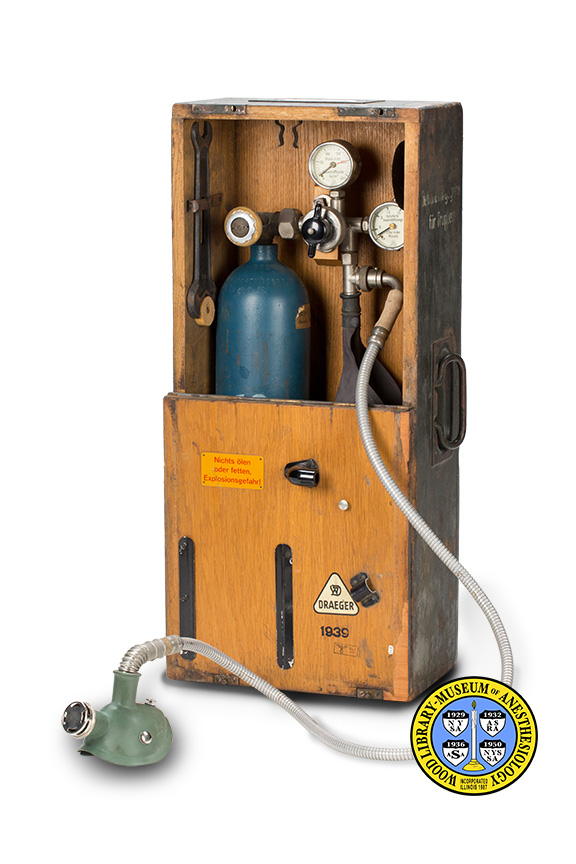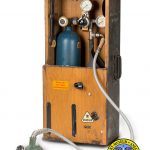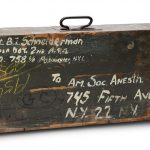Draeger Oxygen Apparatus
Founded in 1889, Drägerwerk AG has always been the primary manufacturer of anesthesia machines in Germany, and has long been one of the most important in the world. The company made anesthesia and resuscitation equipment for German military use in both World Wars. This oxygen apparatus was made in 1939 for medical corps units of the German Army during World War II. These kits were housed in wooden cases that were constructed for easy transportation and storage. They consisted of a pressure gauge, a flow-rate gauge and connection ports that were secured to the inside of the case. A pressurized oxygen cylinder, rubber reservoir bag, mask, headband, mouthpiece, tubing, wrench and instruction manual could all be secured into place with specially made clips, pockets and brackets.
This kit was acquired in 1945 by Anesthesiologist Benjamin I. Schneiderman, MD, (1914-1984) while serving during World War II. Awarded a Bronze Star, Dr. Schneiderman served in the U.S. Army from July, 1942 to January, 1946.
Catalog Record: Draeger Oxygen Apparatus
Access Key: almq
Accession No.: 373
Title: Behandlungsgerät für Truppen / Draeger.
Corporate Author: Draeger.
Title variation: Alt Title
Title: Draeger oxygen apparatus.
Title variation: Alt Title
Title: Sauerstoff-Behandlungsgerät für Truppen.
Title variation: Alt Title
Title: Oxygen treatment device for troops.
Title variation: Alt Title
Title: Oxygen treatment equipment for troops.
Publisher: [Lübeck?] : Draeger, 1939.
Physical Descript 1 respiratory apparatus : metals, wood, rubber, glass, plastics ; 61.8 x 27.7 x 16.7 cm.
Subject: Respiratory Therapy – instrumentation.
Subject: Oxygen – instrumentation.
Subject: World War II.
Subject: Military Medicine – history – Germany.
Note Type: General
Notes: The date for the possible year of manufacture of this device is based on the
year marked on the inside of the lid, just below the Draeger logo (1939). The
date range could change if documentation, or expert opinion, indicates that
it should be corrected.
Note Type: General
Notes: Google Translate translation of Sauerstoff-Behandlungsgerät für Truppen is,
“Oxygen treatment device for troops.” Google Translate Translation of
Behandlungsgerät für Truppen is, “Treatment device for troops.”
Note Type: Citation
Notes: Capt Benjamin I. Schneiderman. Find A Grave website. https://findagrave.
net/cgi-bin/fg.cgi?page=pv&GRid=3750397&PIpi=64736880. Accessed March 15,
2015.
Note Type: Citation
Notes: Dräger-Sauerstoff-Behandlungsgerät für Truppen. Lubeck: Dragerwerk; 1938.
Anweisung MJ 1b, Ausgabe 18.
Note Type: Citation
Notes: Schneiderman, Benjamin, I. [biographical file]. Archives. Located at: Located
at: Wood Library-Museum of Anesthesiology, Schaumburg, Illinois.
Note Type: Physical Description
Notes: One wooden case that houses a unit for administering oxygen in a military
field and medical environment; Measurements and descriptions of this item are
based on placing the case so that the side with the white circle and red
cross painted on it is facing forward, with the case closed; This side will
be referred to as the front; The longer side with a handle and white
stenciled German lettering will be referred to as the right side; The short
side with a handle will be referred to as the top, and the side with a
shipping and return address painted in English lettering will be referred to
as the back; The case is painted a dark green, and there is significant
surface damage to the upper, front side of the case, as well as to the edges
of the back; The paint and wood is worn with small gouges throughout;
Stenciled on the upper right side, in very faded white lettering is,
“Behandlungsgerät [new line] für Truppen”; In the center of the right side is
a metal inset carrying handle; On top, two inset latches are near the front
edge; An inset, carrying handle is also located on the top of the case, in
the center; The inset latches open to allow the top half of the front of the
case to fold open via a hinge in the center of the front of the case; When
open, the oxygen delivery unit and accessories are accessible; On the inside
of the top-half of the front is a nailed on orange plate with red lettering,
“Nichts ölen [new line] oder fetten, [new line] Explosionsgefahr!”; There is
also a decal with the manufacturer’s logo and name, “DRAEGER”; The year 1939
is marked below the decal, and below the year is stamped a symbol of the
Third Reich; Also attached to the inside of the front are pieces for securing
the mask and mouthpiece, and two brackets for holding an instruction booklet
(booklet not with case); Secured inside the case, to the back, is an oxygen
delivery unit with an empty light blue oxygen canister, a canister port with
turn valve, two pressure gauges and a T-knob for adjusting flow; The canister
is marked with the text, “Sauerstoff”; Marked on the pressure gauge is,
“Druckinder” above the center and, “Sauerstoffflasche [new line] kg/cm² [new
line] Draeger” below the center; This pressure gauge is also marked from 0 to
250 with four numbered increments in between (50, 100, 150, 200); The gauge
for the flow of oxygen to the patient is marked, “Gelieferte [new line]
Sauerstoffmenge” above the center, and Liter in der [new line] Minute” below
the center; Below the flow gauge is a connection for tubing to the patient
and for a rubber reservoir bag; The tubing is spiral metal and measures
approximately 105 cm in length; Also inside is a green rubber oronasal mask
with a metal non-rebreathing valve and metal fittings; The rubber of the mask
is dry; There is also a black mouthpiece and a black headband with straps for
holding the oronasal mask in place on a patients’ face; Affixed to the inner
left side is a two-headed wrench and on the right, a metal compartment for
holding the headband/strap; Hand painted in white on the back of the case is
a shipping address and return address; The shipping address, marked “to”, is
“Am. Soc. Anesth. Inc. [new line] 745 Fifth Ave [new line] N.Y. 22, N.Y.; The
return address is, “Capt. B.I. Schneiderman [new line, the next line is very
difficult to read but may be] ETOUSA DOT. 2nd A.S. A. [new line] A.P.O. 758
c/o Postmaster, N.Y.C.”
Note Type: Reproduction
Notes: Photographed by Mr. Steve Donisch November 12, 2014.
Note Type: Acquisition
Notes: Donated to the WLM by Benjamin I. Schneiderman, MD.
Note Type: Historical
Notes: This oxygen kit was made in 1939 for medical corps units of the German Army
during World War II. The manufacturer was Draeger of Lübeck, Germany, a major
manufacturer of medical equipment, including anesthesia machines. The kits
were housed in wooden cases that were constructed for easy transportation and
storage. They consisted of a pressure gauge, a flow-rate gauge and connection
ports that were secured to the inside of the case. A pressurized oxygen
cylinder, rubber reservoir bag, mask, headband, mouthpiece, tubing, wrench
and instruction manual could all be secured into place with specially made
clips, pockets and brackets.
This kit was acquired in 1945 by Anesthesiologist Benjamin I. Schneiderman,
MD, (1914-1984) while serving during World War II. Awarded a Bronze Star, Dr
Schneiderman served in the U.S. Army from July, 1942 to January, 1946.
Note Type: Publication
Notes: Buchner A. The German Army Medical Corps in World War II. Atglen, PA :
Schiffer Publishing; 1999.
Note Type: Publication
Notes: Defalque RJ, Wright AJ. Anesthesia in the Wehrmacht (1939-1945). In: Fink BR,
ed. The History of Anesthesia: Third International Symposium. Park Ridge,
Illinois: Wood Library-Museum of Anesthesiology; 1992:143-146.
Note Type: Exhibition
Notes: Exhibited at the National World War II Museum in New Orleans, October, 2014.



